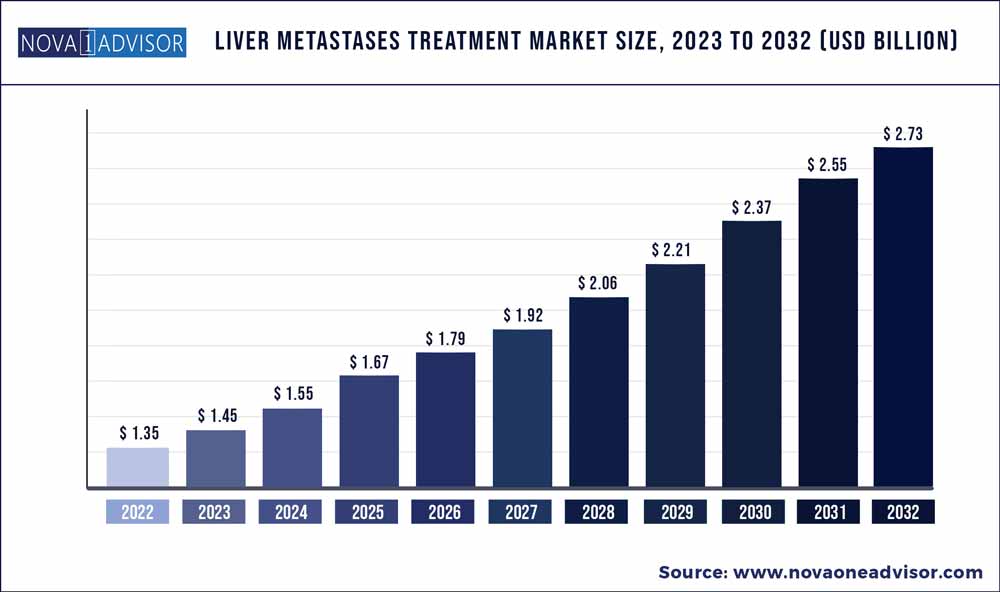The global liver metastases treatment market size was estimated at USD 1.35 billion in 2022 and is expected to surpass around USD 2.73 billion by 2032 and poised to grow at a compound annual growth rate (CAGR) of 7.3% during the forecast period 2023 to 2032.

Key Pointers:
Liver Metastases Treatment Market Report Scope
|
Report Coverage |
Details |
|
Market Size in 2023 |
USD 1.45 Billion |
|
Market Size by 2032 |
USD 2.73 Billion |
|
Growth Rate from 2023 to 2032 |
CAGR of 7.3% |
|
Base year |
2022 |
|
Forecast period |
2023 to 2032 |
|
Segments covered |
Treatment type, Primary cancer, Distribution channel |
|
Regional scope |
North America; Europe; Asia Pacific; Central and South America; the Middle East and Africa |
|
Key companies profiled |
F. Hoffmann-La Roche Ltd.; AstraZeneca; Bayer AG; Eli Lilly and Company; Ono Pharmaceutical; Pfizer, Inc.; Bristol-Myers Squibb Company; Cadila Pharmaceuticals Ltd. |
This can be attributed to the rising incidence of the target disease. According to the National Library of Medicine, approximately 5.15% of total cancer cases were diagnosed with synchronous metastatic hepatocellular cancer in 2020. Breast cancer and colorectal cancer are the most common sites for liver metastases in young women and men. The rising number of cases is thus expected to boost demand for drugs over the forecast period. Moreover, growing research in the field positively contributes to market growth. Several government and non-profit organizations are actively involved in research activities. For instance, the National Cancer Institute is running a program P01 focusing on understanding the common mechanism involved in the development of liver metastases using disparate tumor models. Successful completion of the study is expected to boost the development of novel diagnostics and medicines for treatment in the coming years.
However, the lack of proper availability of diagnostic and treatment methods for liver metastases is expected to slow down the market growth worldwide. Currently, the diagnosis of colorectal cancer liver metastases is performed with help of focal biopsy and imaging examinations but the lack of sensitivity in imaging diagnosis of hepatocellular carcinoma consequently restrains the market growth. Therefore, it is necessary to develop appropriate and novel methods for diagnostics.
Radiation therapy, ablation treatments, and surgery are some of the most commonly used treatments for metastasized hepatocellular carcinoma. The availability and wide usage of these treatments are expected to restrain the market growth of the liver metastases treatment drugs market.
North America dominated the global market in terms of the revenue share of 40.92% in 2022. The favorable reimbursement policies for stage 4 cancers and the availability of advanced treatment options improve access to treatment. There are around 140,000 people with liver metastases annually in the U.S. Additionally, in May 2020, the U.S. FDA approved atezolizumab in combination with bevacizumab for the treatment of patients suffering from advanced metastatic hepatocellular carcinoma. The approval and adoption of such targeted therapy agents are expected to drive market growth.
Asia Pacific is expected to expand at the highest CAGR during the forecast period owing to the increase in target disease prevalence. The increasing healthcare expenditure and insurance coverage in the region is further expected to aid market growth. Due to a lack of effective screening practices and access to healthcare in this region cancers are mostly diagnosed at advanced stages. This represents a key growth opportunity for the market.
Liver Metastases Treatment Market Segmentation
| By Treatment Type | By Primary Cancer | By Distribution Channel |
|
|
|